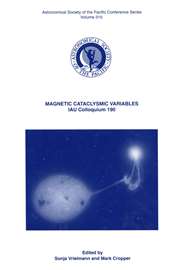Article contents
Physical Interpretation of Dwarf Nova Primary Effective Temperatures
Published online by Cambridge University Press: 22 February 2018
Abstract
We have undertaken a theoretical study of the impact of the accumulating envelopes on the thermal state of the underlying white dwarf (WD). This has allowed us to find the equilibrium WD core temperatures, the classical nova ignition masses and the thermal luminosities for WDs accreting at rates of 10–11 – 10–8M ⊙ yr–1. These accretion rates are most, appropriate to WDs in cataclysmic variables (CVs) of (P orb ≲ 7 hr), many of which accrete sporadically as Dwarf Novae. Over twenty Dwarf Novae have been observed in quiescence, when the accretion rate is low and the WD photosphere is detected and T eff measured. Comparing our theoretical work to these observations allows us to constrain the WD mass and the time averaged accretion rate, ⟨Ṁ⟩. If ⟨Ṁ⟩ is that given by gravitational radiation losses alone, then the WD masses are > 0.8 M ⊙. An alternative conclusion is that the masses are closer to 0.6M ⊙ and ⟨Ṁ⟩ is 3-4 times larger than that expected from gravitational radiation losses.
Resumen
Hemos llevado a cabo un estudio teórico del impacto de las envolventes acumulativas sobre el estado térmico de la enana, blanca subyacente (WD). Esto nos permitió encontrar las temperaturas de equilibrio del núcleo de la WD, las masas de ignición de la nova clásica y las luminosidades térmicas de WDs que llevan a cabo acreción con tasas de 10–11 – 10–8M ⊙ yr–1. Estas tasas de acreción son las más apropiadas para WDs en variables cataclísmicas (CVs) de (P orb ≲ 7 hr), muchas de las cuales llevan a cabo acreción de manera esporádica como Novas Enanas. Fueron observadas más de veinte Novas Enanas en reposo, cuando la tasa de acreción es baja siendo posible detectar la fotosfera de la WD y medir la temperatura T eff. Comparando nuestro trabajo teórico con estas observaciones podemos restringir la niasa de la WD y la tasa de acreción promediada en el tiempo, ⟨Ṁ⟩. Si ⟨Ṁ⟩ es la dada solamente mediante pérdidas de radiación gravitacional entonces las masas de WD son > 0.8 M ⊙. Una conclusión alterna es que las masas se encuentran más cerca de 0.6M ⊙ y (⟨Ṁ⟩) es 3-4 veces mayor que la, esperada en base a pérdidas de radiación gravitacional.
Information
- Type
- The Contributed Papers
- Information
- International Astronomical Union Colloquium , Volume 194: Compact binaries in the galaxy and beyond , 2004 , pp. 192 - 193
- Copyright
- Copyright © Instituto de astronomia/revista mexicana de astronomίa y astrofίsica 2004
References
- 1
- Cited by

